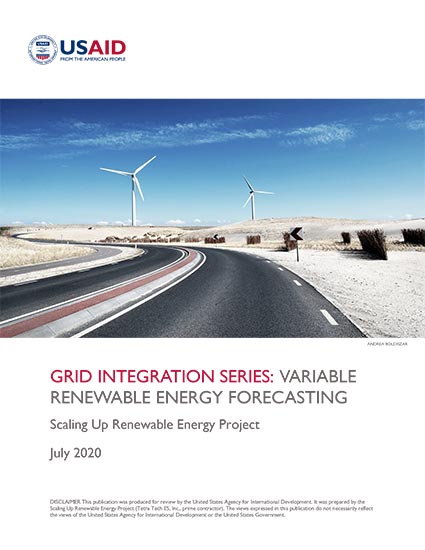- Energy Home
- How We Work
- Programs & Initiatives
- EmPOWERing Women and Girls
- Competitive Energy Procurement
- Auctions Toolkit
- Introduction
- Design
- Renewable Energy Integration
- Training
- Country Experience
- Resources
- Why Auctions?
- Designing RE Auctions
- Stages of Design
- Design Process
- Prequalification & Ceiling Prices
- Financial Guarantees & Penalties
- System-friendly Procurement
- Technology Selection
- Variable RE Forecasting
- Impact on System Operations
- System-friendly Procurement in Bangladesh
- Variable RE in Bangladesh
- Auctions Toolkit
- Toolkits
- Monitoring & Evaluation
- Resources
- Stories
Speeches Shim
Barriers to Grid Integration Series
Grid operators and regulators can use variable renewable energy (VRE) generation forecasting as a cost-effective method for addressing the barriers to the grid integration of VRE.
As auction programs mature and the share of variable renewable energy (VRE) in power systems increases, many countries find that grid integration concerns become a real barrier to scaling up renewable energy. Policymakers’ objectives often evolve from low power generation costs to enhancing dispatchability and improving the value of renewable energy.
VRE forecasting is essential to integrating VRE into the grid. When system operators fail to or inaccurately forecast VRE, the grid may experience lower reliability and higher cost, even when VRE penetration is modest. The consequences include VRE curtailment, frequency and voltage excursions due to over- or under-generation, negative market prices, price volatility, and dropped load.
What is VRE Forecasting?
VRE forecasting is the short-term prediction of future VRE power plant output, generally on week-ahead, day-ahead, or intraday timescales. The time intervals of intraday forecasting can be hour-ahead (HA), 15 minutes-ahead (15MA), or 5 minutes-ahead (5MA). The duration, or time horizon, of intraday forecasting can be for the following few hours or through the end of the day. VRE forecasting supports system operators in performing dispatch planning to develop a schedule that balances generation with load, while managing appropriate amounts of reserves.
VRE forecasting has emerged as a cost-effective method for reducing the impact of VRE integration on the grid and as a least-cost solution to enhance grid flexibility—a requirement for increased VRE penetration. VRE forecasting is part of a portfolio of tools and processes that enable policymakers to “green the grid.”
Why is VRE Forecasting Important for Grid Integration of VRE?
VRE forecasting has become an indispensable tool for system operators in grids with modest to large amounts of VRE, in countries with and without real-time power markets. With accurate day-ahead and intraday VRE forecasting, system operators can make decisions about committing, de-committing, or reducing the capacity factors of conventional generators while maintaining high-reliability and low-cost generation. Without VRE forecasting, or with less accurate forecasting processes, system operators cannot adjust the level of production from inflexible conventional generators and must resort to curtailing VRE. VRE forecasting provides them the tools to exploit the flexibility of all conventional generators and thus reduce curtailments and increase VRE penetration.
In countries with no real-time power market, VRE forecasting improves the core functions of system operations: unit commitment, economic dispatch, real-time balancing of supply and demand, and reserves planning.
VRE forecasting provides four key benefits that are essential to emerging market grid operators and regulators:
- Reduces reserve requirements needed to manage deviations between dispatched generation and demand, helping supply-constrained systems.
- Improves system flexibility by providing accurate VRE generation forecasts, allowing the system to optimize its entire generation fleet, which is often unutilized or underutilized.
- Reduces curtailments, allowing more renewables to be economically scheduled.
- Increases system reliability because better forecasting allows for significantly lower levels of volatility in the supply-demand balance, resulting in higher overall reliability.
Challenges in Developing Countries and the Way Forward
There are a number of challenges in solar and wind generation forecasting that apply to vertically integrated and deregulated electricity sectors. Countries that are new to VRE or have not implemented a comprehensive VRE forecasting program can follow recommended solutions informed by best practices.
-
Outdated policy and regulatory design
- Specify design details in policies and grid codes pertaining to VRE forecasting: (1) forecasting to be adopted: centralized, decentralized or hybrid; (2) forecast time block, horizon and lead time for day ahead, intraday or other forecast; (3) obligation of plants to provide data required for VRE forecasting
- Synchronize VRE forecasting policy with the requirements for forecasting load, faster dispatching, and others that increase grid flexibility, such as demand response, pricing of ancillary services, and pricing for curtailment
-
Lack of capacity in system operations
- Centralized forecasting
- Procuring VRE forecasting services from experienced vendors
-
Suboptimal dispatching practices at system operations
- Operational reforms that include sub-hourly dispatching
- Integration of VRE forecasting with the dispatching process
- Use of sophisticated tools for dispatching that are part of energy management systems
-
Inaccurate weather forecasts
- Use existing meteorological research institutions in the region or establish new institutions to conduct research to improve forecasting accuracy
- Install meteorological stations, create weather models, downscale global weather data, perform statistical analysis for bias removal, model local weather phenomena, and generate accurate weather forecasts



Comment
Make a general inquiry or suggest an improvement.